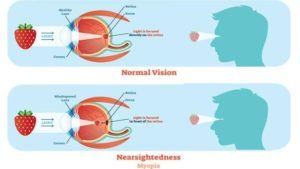
Myopia
Myopia or shortsightedness is turning out to be an epidemic across india, and indeed even more in Southeast Asia. At this rate, by 2050, 64 million children in urban India may have myopia
- The inability to see the distant objects clearly and distinctly is called short-sightedness. This defect arises when the image is formed infront of the retina.
- A short-sighted person can see near objects clearly. This may arise due to either excessive curvature of the cornea or elongation of the eyeball.
- This defect is corrected by wearing glasses with a concave lens.

- Myopia first occurs in school-age children. Because the eye continues to grow during childhood, it typically progresses until about age 20.
- However, myopia may also develop in adults due to visual stress or health conditions such as diabetes.
- Some people may experience blurred distance vision only at night. With “night myopia,” low light makes it difficult for the eyes to focus properly. Or the increased pupil size during dark conditions allows more peripheral, unfocused light rays to enter the eye.
- People who do an excessive amount of near-vision work may experience a false or “pseudo” myopia. Their blurred distance vision is caused by overuse of the eyes’ focusing mechanism.
- After long periods of near work, their eyes are unable to refocus to see clearly in the distance. Clear distance vision usually returns after resting the eyes. However, constant visual stress may lead to a permanent reduction in distance vision over time.

